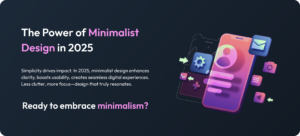
1.Let’s be honest: We’re living in a world where distractions are everywhere. From pop-up ads screaming for your attention to apps trying to “ping” their way into your life, our brains are overstimulated and ready to revolt. And this is exactly why minimalist design is having a major moment in 2025.
Now, before you picture white walls and one sad chair sitting alone in a vast room, let me assure you that minimalist design is so much more than just cutting things out. It’s about creating spaces, both physical and digital, that are purposeful, functional, and—dare I say it—seriously good-looking.
So grab a cup of coffee (or green juice, if that’s your vibe), and let’s dive into the world of Minimalist Design Trends that are transforming how we interact with our environments, apps, and, well… life.
What Exactly Is Minimalist Design?
Clean Design UI and Simple Design Principles are all about stripping away the unnecessary and focusing on what truly matters. In 2025, this translates to designs that feel fresh, functional, and easy on the eyes.
Picture this: You open a website, and instead of being bombarded with pop-ups, carousels, and neon fonts that scream “Buy now or cry later!” you’re greeted by a clean, well-structured layout. The text is easy to read. The call-to-action is clear. And the negative space? Oh, it’s chef’s kiss.
This brings us to Negative Space UX, one of the unsung heroes of minimalist design. Negative space (a.k.a. the glorious empty space around design elements) isn’t wasted space—it’s a power move. It lets your eyes breathe, your brain process, and your inner peace… stay intact.
Why Minimalist Design Trends Matter in 2025
Let’s face it: Attention spans in 2025 are shorter than a TikTok video. If your design isn’t clear, concise, and visually soothing, people will bounce faster than you can say, “Where’s the close button?”
That’s where Functional Minimalism comes in. It’s not about being flashy; it’s about being useful.
Take app interfaces, for example. Users want designs that don’t make them think. (We’ve all been there, staring at a screen, wondering, “Is this an add-to-cart button or a self-destruct button?”) Clean Design UI ensures that everything has a purpose, from the size of a button to the spacing between lines of text.
In 2025, we’re seeing this trend explode across websites, apps, and even physical spaces. Apple, Google, and other design giants are doubling down on Minimal UI Patterns—repeating design elements that are simple yet effective. Think consistent icons, intuitive navigation menus, and interfaces that feel familiar, even when they’re new.
The Role of Negative Space UX
Let’s pause for a second to appreciate the art of not doing too much.
Imagine a painting where every inch is covered in bold colors and chaotic patterns. It’s overwhelming, right? Now imagine a minimalist painting: a single brushstroke, carefully placed on a blank canvas. Suddenly, that stroke has meaning, impact, and elegance.
That’s exactly what Negative Space UX does in design. It helps users focus on what matters most.
For example, when designing a website, negative space can guide the user’s eye to the call-to-action button, making it impossible to miss. It’s like your design is gently saying, “Hey, look over here. This is important.”
Pro tip: If you want to impress your designer friends at parties, casually drop the term “negative space.” Then watch as their eyes light up with respect.
Minimalism with Personality
Here’s the thing about minimalist design: Some people think it’s boring. Too plain. Lacking in personality. But those people are wrong. (Sorry, I don’t make the rules.)
Minimalist design in 2025 isn’t about removing all personality; it’s about finding balance. You can have bold typography, a pop of color, or playful micro-interactions—all within the boundaries of Simple Design Principles.
Take Airbnb’s app, for example. It’s clean and minimalist, sure, but it also feels human. The soft colors, friendly fonts, and intuitive layout make you feel at home (pun intended). This is Functional Minimalism at its finest: simplicity with a side of charm.
And let’s not forget animation. A subtle hover effect here, a smooth transition there—it’s the digital equivalent of a wink. Just enough to keep things interesting without going overboard.
How to Nail Minimalist Design
Alright, you’re sold on the power of minimalist design. But how do you actually do it? Here are some golden rules:
- Start with a Purpose
Every element in your design should serve a purpose. If it doesn’t, it’s clutter. - Master the Art of Negative Space UX
Don’t be afraid of blank space—it’s your secret weapon. Use it to highlight what’s important and give your users some breathing room. - Stick to Minimal UI Patterns
Consistency is key. Use simple, intuitive patterns that guide users seamlessly through your design. - Keep It Functional
Remember, Functional Minimalism is all about usability. Don’t sacrifice functionality for aesthetics—find a way to balance both. - Add a Dash of Personality
Minimalist doesn’t mean boring. A touch of color, a playful icon, or a clever micro-interaction can go a long way.
The Future of Minimalist Design
So, what’s next for minimalist design?
In 2025, we’re seeing a shift toward adaptive minimalism. This means designs that adapt to the user’s needs, preferences, and environment. Think apps that change their layout based on how you hold your phone, or websites that simplify their interface for first-time users.
We’re also seeing Minimalist Design Trends extend beyond the digital world. Physical spaces, from coworking hubs to coffee shops, are embracing clean lines, open layouts, and neutral tones. (Because who doesn’t want their workspace to look like a Pinterest board?)
And let’s not forget sustainability. Minimalist design often goes hand-in-hand with eco-friendly practices, like using fewer materials or designing with longevity in mind. So, not only does minimalism look good—it does good, too.
Why You’ll Love Minimalism Even If You Don’t Think You Will
Let’s end with a confession: Minimalism isn’t for everyone—at least, not at first.
If you’re someone who loves bold, eclectic designs, the idea of simplicity might feel… underwhelming. But here’s the thing: Minimalism grows on you.
It’s like switching from soda to sparkling water. At first, it feels like something’s missing. But over time, you realize how refreshing it is. Minimalism isn’t about what you lose—it’s about what you gain: clarity, functionality, and a design that just works.
So, the next time you’re designing a website, decorating a room, or even organizing your closet, remember the magic of Simple Design Principles, Functional Minimalism, and Negative Space UX. Because in 2025, less really is more.
And hey, if all else fails, just throw in some negative space and call it a day. Your users (and your brain) will thank you.
Closing Thoughts
Whether you’re a designer, a business owner, or just someone trying to make sense of this chaotic world, minimalist design has something to offer. It’s not about perfection—it’s about purpose.
So go forth and embrace the power of Minimalist Design Trends! Who knows? You might just find that a little simplicity can make life (and design) a whole lot better.
